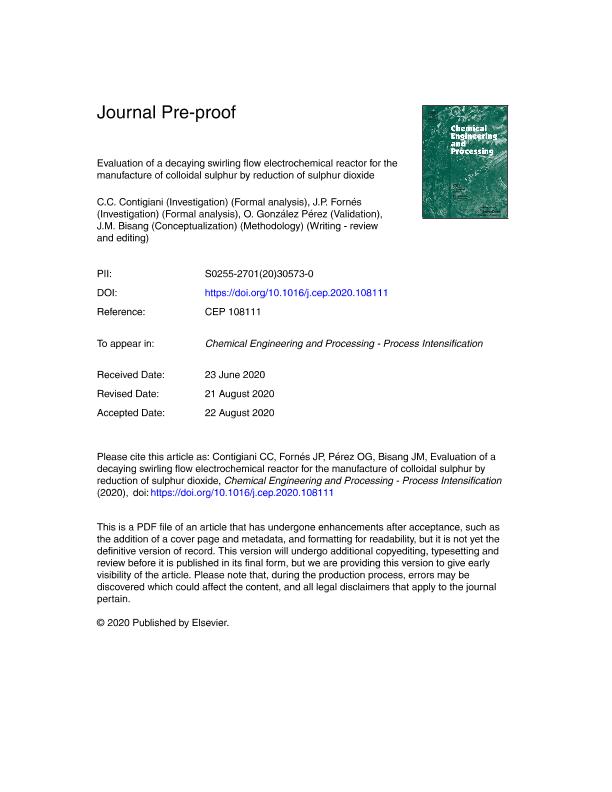Mostrar el registro sencillo del ítem
dc.contributor.author
Contigiani, Camila Cecilia

dc.contributor.author
Fornés, J. P.
dc.contributor.author
González Pérez, Omar

dc.contributor.author
Bisang, Jose Maria

dc.date.available
2022-10-24T11:02:02Z
dc.date.issued
2020-11
dc.identifier.citation
Contigiani, Camila Cecilia; Fornés, J. P.; González Pérez, Omar; Bisang, Jose Maria; Evaluation of a decaying swirling flow electrochemical reactor for the manufacture of colloidal sulphur by reduction of sulphur dioxide; Elsevier Science SA; Chemical Engineering and Processing; 157; 11-2020; 108111-108118
dc.identifier.issn
0255-2701
dc.identifier.uri
http://hdl.handle.net/11336/174470
dc.description.abstract
The behaviour of an electrochemical reactor with decaying swirling flow is analysed for the production of colloidal sulphur using sulphur dioxide from synthetic effluents as raw material. The experiments were done under potentiostatic control with single- and two-phase flow. The best results were obtained at a cathodic potential of −0.7 V, against a saturated calomel electrode. Thus, in a single-phase experiment at a volumetric flow rate of 8 dm3 min−1 and 1 g dm−3 SO2 in 0.5 mol dm−3 H2SO4 as a supporting electrolyte, the current efficiency was 64% with a specific energy consumption of 22.7 kW h kg−1 and a space time yield of 5.6 kg m−3 h−1, achieving a total removal of sulphur dioxide after 15 min of operation. For sulphur dioxide concentrations lower than 2.5 g dm−3 the cathode surface remained free of a sulphur layer due to the impingement action of the swirling flow. Similar results were obtained under a two-phase flow of 5% SO2 in nitrogen. In this case, the sulphur particles presented mainly spheroidal shape with an average size of 2.8 μm being of high purity. The comparison with other types of electrochemical reactors concludes that the equipment with swirling flow represents the best option.
dc.format
application/pdf
dc.language.iso
eng
dc.publisher
Elsevier Science SA

dc.rights
info:eu-repo/semantics/openAccess
dc.rights.uri
https://creativecommons.org/licenses/by-nc-sa/2.5/ar/
dc.subject
COLLOIDAL SULPHUR
dc.subject
ELECTROCHEMICAL REACTOR
dc.subject
SULPHUR DIOXIDE
dc.subject
SWIRLING FLOW
dc.subject.classification
Otras Ingeniería Química

dc.subject.classification
Ingeniería Química

dc.subject.classification
INGENIERÍAS Y TECNOLOGÍAS

dc.title
Evaluation of a decaying swirling flow electrochemical reactor for the manufacture of colloidal sulphur by reduction of sulphur dioxide
dc.type
info:eu-repo/semantics/article
dc.type
info:ar-repo/semantics/artículo
dc.type
info:eu-repo/semantics/publishedVersion
dc.date.updated
2022-09-22T15:09:52Z
dc.journal.volume
157
dc.journal.pagination
108111-108118
dc.journal.pais
Países Bajos

dc.journal.ciudad
Amsterdam
dc.description.fil
Fil: Contigiani, Camila Cecilia. Universidad Nacional del Litoral. Facultad de Ingeniería Química. Programa de Electroquímica Aplicada e Ingeniería Electroquímica; Argentina. Consejo Nacional de Investigaciones Científicas y Técnicas. Centro Científico Tecnológico Conicet - Santa Fe; Argentina
dc.description.fil
Fil: Fornés, J. P.. Universidad Nacional del Litoral. Facultad de Ingeniería Química. Programa de Electroquímica Aplicada e Ingeniería Electroquímica; Argentina
dc.description.fil
Fil: González Pérez, Omar. Universidad Nacional del Litoral. Facultad de Ingeniería Química. Programa de Electroquímica Aplicada e Ingeniería Electroquímica; Argentina
dc.description.fil
Fil: Bisang, Jose Maria. Universidad Nacional del Litoral. Facultad de Ingeniería Química. Programa de Electroquímica Aplicada e Ingeniería Electroquímica; Argentina. Consejo Nacional de Investigaciones Científicas y Técnicas. Centro Científico Tecnológico Conicet - Santa Fe; Argentina
dc.journal.title
Chemical Engineering and Processing

dc.relation.alternativeid
info:eu-repo/semantics/altIdentifier/url/https://linkinghub.elsevier.com/retrieve/pii/S0255270120305730
dc.relation.alternativeid
info:eu-repo/semantics/altIdentifier/doi/http://dx.doi.org/10.1016/j.cep.2020.108111
Archivos asociados
